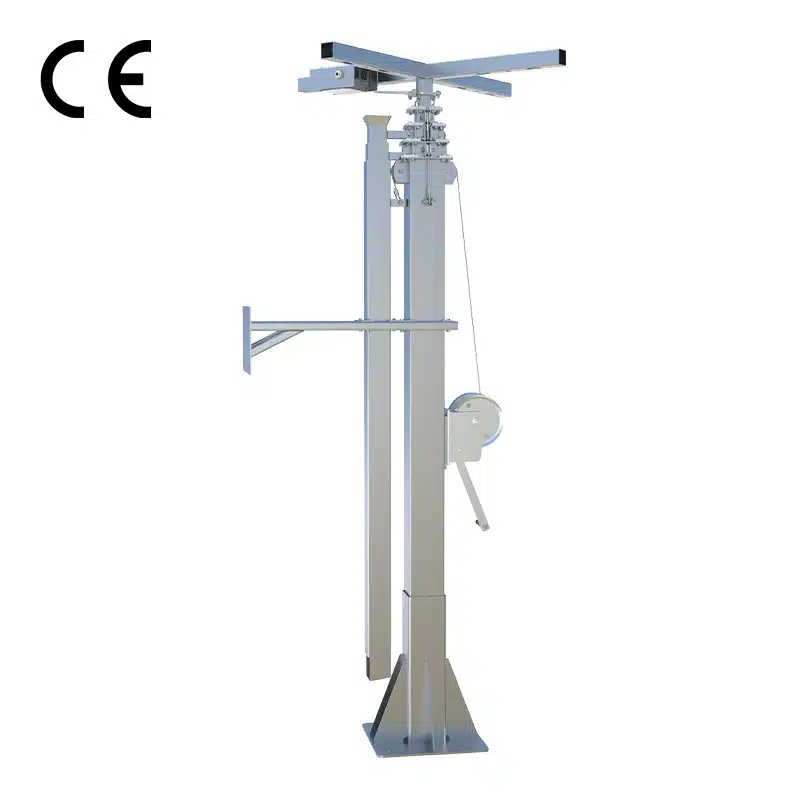Mât télescopique
Plage de prix : € 1.830,00 à € 3.230,00 Excl. VAT

Description
Mât télescopique pour installation fixe, réglable en hauteur de 6 à 8 mètres avec alimentation intégrée.
Informations complémentaires
| Lampe LED | Aucun, 2 x 100W (34 000 lm), 4 x 100W (68 000 lm), 2 x 200W (68 000 lm), 4 x 200W (136 000 lm), 2 x 300W (102 000 lm), 4 x 300W (204 000 lm) |
|---|---|
| Hauteur maximale | 6 mètres, 8,5 mètres |
| Largeur de la traverse | 80 cm |
| Largeur de la base | 40 cm |
| Largeur jusqu’au treuil | 30 cm |
| Profondeur du mât | 47 cm |
| Treuil manuel | 1800 lbs certifié CE |
| Dimensions de la base | 80 cm x 80 cm |
| Fixation | Base avec trous de fixation et support mural |
| Matériau | Galvanisé |
| Boîte de raccordement | IP66, comprenant un interrupteur marche/arrêt |
| Tube latéral | Tube latéral télescopique pour la protection des câbles |
| Électricité | Prise européenne |
| Boîte de jonction | Comprend une connexion spéciale pour la lampe LED de 200W |
Mât réglable pour installations permanentes
Le mât télescopique est un mât robuste, réglable en hauteur, spécialement conçu pour les installations permanentes sur des bâtiments, des sites ou des projets d’infrastructure. Grâce à sa construction solide et sa base galvanisée, le mât est très résistant aux conditions météorologiques et aux charges à long terme.
Hauteur flexible et fonctionnement facile
Grâce à un treuil manuel avec une capacité de charge de 1 800 lbs, le mât peut être facilement ajusté à la hauteur souhaitée — jusqu’à 6 ou 8 mètres, selon le modèle. Cela le rend idéal pour une large gamme d’applications telles que la surveillance par caméra, l’éclairage ou l’installation de capteurs, où la hauteur et la visibilité sont essentielles.
Alimentation intégrée
Le mât est équipé d’une boîte de raccordement IP66 avec un interrupteur marche/arrêt pour un contrôle simple. Un câble spiralé à trois conducteurs et une boîte de distribution pour les lampes garantissent une gestion de l’alimentation sécurisée et bien organisée. La prise européenne permet une connexion directe au réseau électrique.
Montage stable et sécurisé
La base galvanisée incluse offre une fondation solide pour l’installation sur béton ou acier, tandis que le support mural ajoute une stabilité et une fixation supplémentaires. Cela fait du mât un choix fiable pour les installations permanentes où la durabilité et la sécurité sont essentielles.
Livraison rapide

Paiement sécurisé
Garantie de qualité
Calculate how many light poles you need
Light tower with two lamps (directed to one side) at a height of 6 meters
Light tower with two lamps (directed to one side) at a height of 8.5 meters
Light tower with four lamps (directed to all sides) at a height of 8.5 meters
How much lux does my area need?
Guidelines for Outdoor Lighting – Recommended Lux Levels
When lighting outdoor spaces, it’s important to use the appropriate light intensity. According to the EN 12464-2 standard, the following guidelines apply:
Roads and Traffic
- Footpaths & cycle paths: 5–15 lux
- Residential streets: 10–20 lux
- Main roads with mixed traffic: 20–50 lux
Parking Areas
- Light use (e.g., residential buildings): 5 lux
- Medium use (e.g., shopping centers): 10 lux
- Heavy use (e.g., industrial sites): 20 lux
Outdoor Workspaces
- Loading & unloading zones: 50 lux
- Outdoor storage areas: 20 lux
- Construction sites: 50–100 lux
Important Note
The EN 12464-2 standard provides guidelines for lighting levels (lux) in outdoor workspaces, including parking lots and roads, and applies in the Netherlands and Belgium. However, required lighting levels may vary based on specific situations and local regulations. It’s recommended to conduct further research and consult a lighting specialist to ensure compliance with applicable standards and safety requirements. Also, check national and municipal regulations for the most accurate information.
For more details, visit the BEGA website.
Would you like more information or advice on the right lighting for your project? Contact us!
What is the difference between a light towers with two lamps and a light towers with four lamps?
A light tower with two lamps illuminates one side of the area and provides directional light distribution. This is suitable for situations where only a part of the area needs to be illuminated, such as along a path or driveway.
A light tower with four lamps spreads light in all directions, offering broader coverage. This ensures a larger area is evenly lit, making it ideal for open spaces such as parking lots or construction sites. The number of towers required depends on the desired light intensity (lux) and the size of the area.
How does the height of the light tower affect the lighting of my area?
The height of the light tower influences light distribution and shadow formation. Taller towers provide a wider spread of light and reduce the number of dark spots on the area. However, if the towers are too tall, the light intensity per square meter may decrease, meaning additional lamps might be required to achieve the desired lux level.
With a lower mounting height, shadows and uneven lighting can occur, especially if there are obstacles on the site. Therefore, it’s important to find a balance between height, light intensity, and the number of towers needed for efficient lighting.




0 commentaires